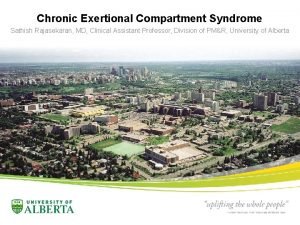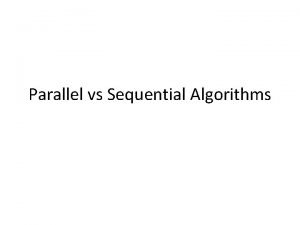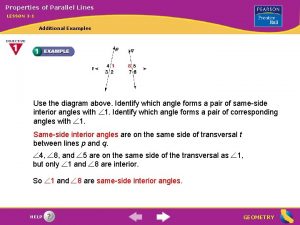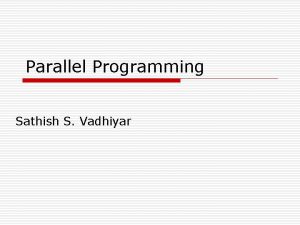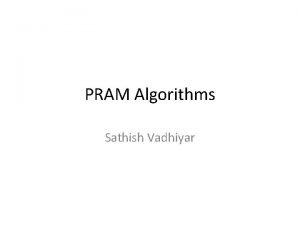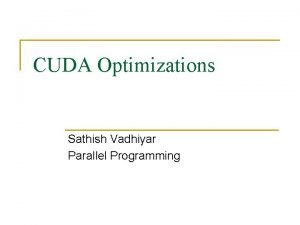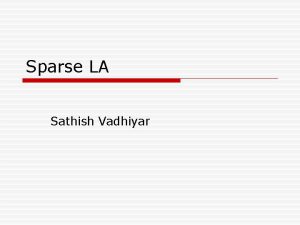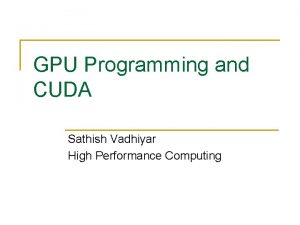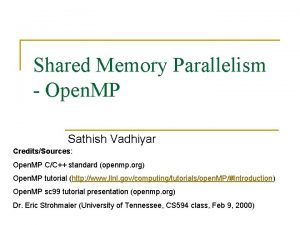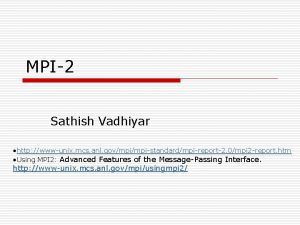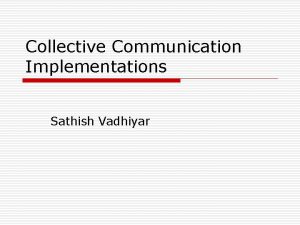Parallel FFT Sathish Vadhiyar Sequential FFT Quick Review
















- Slides: 16

Parallel FFT Sathish Vadhiyar

Sequential FFT – Quick Review o widdle factor – primitive nth complex plane - T root of unity in

Sequential FFT – Quick Review o (n/2)th root of unity o 2 (n/2)-point DFTs

Sequential FFT – quick review X(0) wn 0 Y(0) wn 4 wn 2 wn 1 Y(1) wn 0 wn 4 wn 2 Y(2) wn 4 wn 6 wn 3 Y(3) wn 0 wn 4 X(5) wn 4 wn 2 wn 5 X(3) wn 0 wn 4 wn 6 X(7) wn 4 wn 6 wn 7 X(4) X(2) X(6) X(1) Y(4) Y(5) Y(6) Y(7)

Sequential FFT – recursive solution 1. procedure R_FFT(X, Y, n, w) 2. if (n=1) then Y[0] : = X[0] else 3. begin 4. R_FFT(<X(0), X(2), …, X[n-2]>, <Q[0], Q[1], …, Q[n/2]>, n/2, w 2) 5. R_FFT(<X(1), X(3), …, X[n-1]>, <T[0], T[1], …, T[n/2]>, n/2, w 2) 6. for i : = 0 to n-1 do 7. Y[i] : = Q[i mod (n/2)] + wi. T(i mod (n/2)]; 8. end R_FFT

Sequential FFT – iterative solution 1. 2. 3. 4. 5. 6. 7. 8. 9. 10. 11. 12. 13. 14. 15. 16. procedure ITERATIVE_FFT(X, Y, n) begin r : = log n; for i: = 0 to n-1 do R[i] : = X[i]; for m: = 0 to r-1 do begin for i: = 0 to n-1 do S[i] : = R[i]; for i: = 0 to n-1 do begin /* Let (b 0, b 1, b 2, … br-1) be the binary representation of i */ j : = (b 0 … bm-10 bm+1. . br-1); k : = (b 0 … bm-11 bm+1. . br-1); R[i] : = S[j] + S[k] x w(bmbm-1. . b 00. . 0) ; endfor; for i: = 0 to n-1 do Y[i] : = R[i]; end ITERATIVE_FFT

Example of w calculation m/ 0 1 2 3 4 5 6 7 i 0 000 000 100 100 1 000 100 010 110 2 000 100 010 110 001 101 011 111 For a given m and i, the power of w is computed by reversing the order of the m+1 most significant bits of i and padding them by 0’s to the right.

Parallel FFT – Binary exchange 000 X(0) Y(0) P 0 001 X(1) Y(4) 010 X(2) Y(2) 011 X(3) Y(6) 100 X(4) Y(1) 101 X(5) Y(5) 110 X(3) Y(3) 111 X(7) Y(7) d r P 1 P 2 P 3

Binary Exchange o d – number of bits for representing processes; r – number of bits representing the elements o The d most significant bits of element i indicate the process that the element belongs to. o Only the first d of the r iterations require communication o In a given iteration, m, a process i communicates with only one other process obtained by flipping the (m+1)th MSB of i o Total execution time - ? (n/P)log. N + log. P(l) + (n/P)log. P (b)

Parallel FFT – 2 D Transpose P 0 P 1 P 2 P 3 0 1 2 3 4 5 6 7 8 9 10 11 12 13 14 15 m=0 m=1 Phase 1 – FFTs along columns

Parallel FFT – 2 D Transpose P 0 P 1 P 2 P 3 0 1 2 3 0 4 8 12 4 5 6 7 1 5 9 13 8 9 10 11 2 6 10 14 12 13 14 15 3 7 11 15 Phase 2 – Transpose

Parallel FFT – 2 D Transpose P 0 P 1 P 2 P 3 0 4 8 12 1 5 9 13 2 6 10 14 3 7 11 15 m=2 m=3 Phase 3 – FFTs along columns

2 D Transpose o In general, n elements arranged as √n x √n o p processes arranged along columns. Each process owns √n/p columns o Each process does √n/p FFTs of size √n each o Parallel runtime – 2(√n/p)√nlog√n + (p-1)(l)+ n/p(b)

3 D Transpose o o n 1/3 x n 1/3 elements √p x √p processes Steps ? Parallel runtime – (n/p)logn(c) + 2(√p-1)(l) + 2(n/p)(b)

In general o For q dimensions: o Parallel runtime – (n/p)logn + (q-1)(p 1/(q-1) [l]+ (q-1)(n/p) [b] o Time due to latency decreases; due to bandwidth increases o For implementation – only 2 D and 3 D transposes are feasible. Moreover, there are restrictions on n and p in terms of q.

Choice of algorithm o Binary exchange – small latency, large bandwidth o 2 D transpose – large latency, small bandwidth o Other transposes lie between binary exchange and 2 D transpose o For a given parallel computer, based on l and b, different algorithms can give different performances for different problem sizes
 Dr sathish rajasekaran
Dr sathish rajasekaran Sathish srinivasan
Sathish srinivasan Sathish rajasekaran
Sathish rajasekaran Quick find algorithm
Quick find algorithm Collision forces quick check
Collision forces quick check Sequential parallel comparison design
Sequential parallel comparison design Parallel vs sequential algorithms
Parallel vs sequential algorithms Verilog
Verilog Properties of parallel lines quick check
Properties of parallel lines quick check Iop conjugations
Iop conjugations A quick review of perfect competition and monopoly
A quick review of perfect competition and monopoly Python quick review
Python quick review Unlike parallel force
Unlike parallel force Outer terminus in fingerprint
Outer terminus in fingerprint Parallelism rules
Parallelism rules Parallel construction.
Parallel construction. Mary likes hiking swimming and to ride a bicycle
Mary likes hiking swimming and to ride a bicycle


